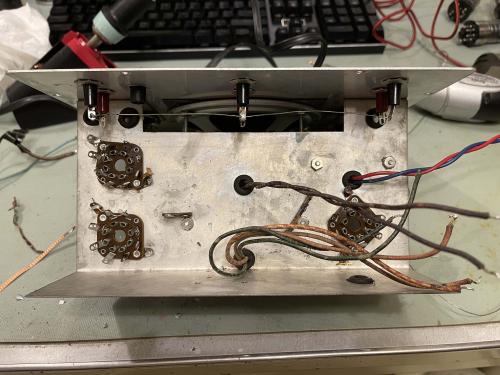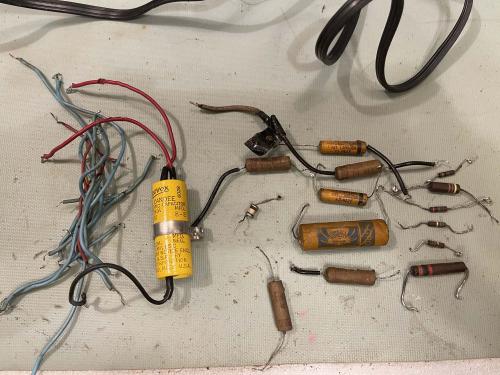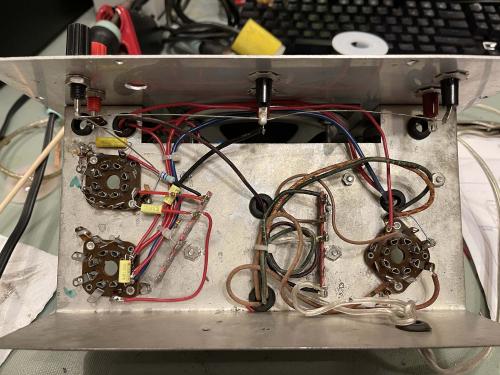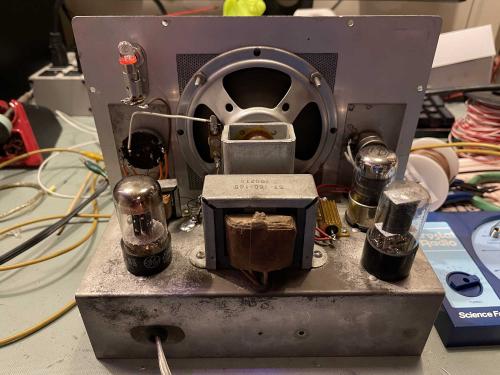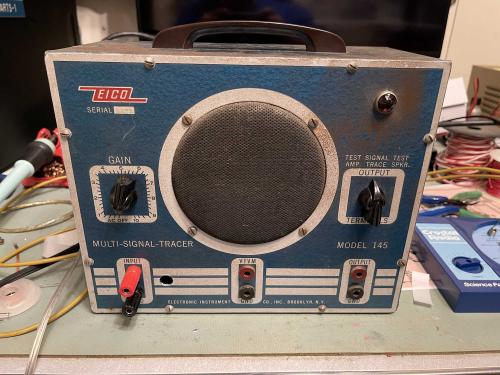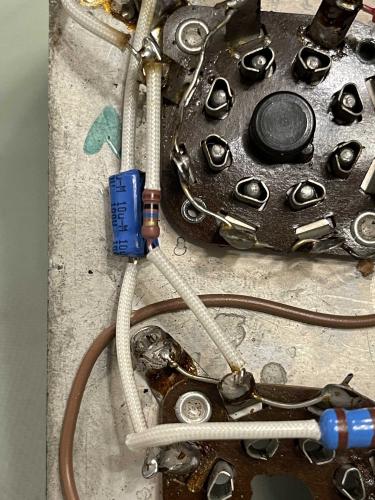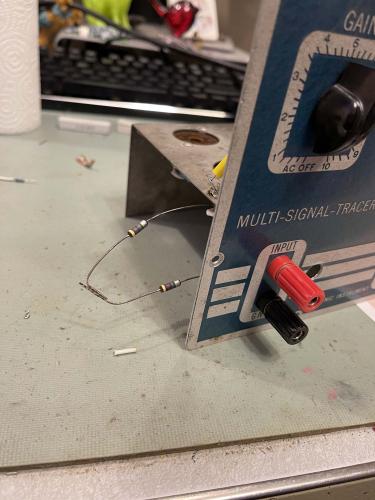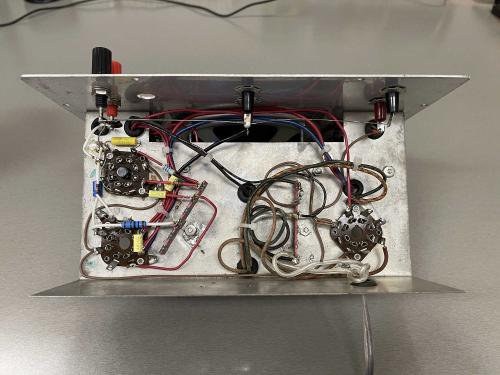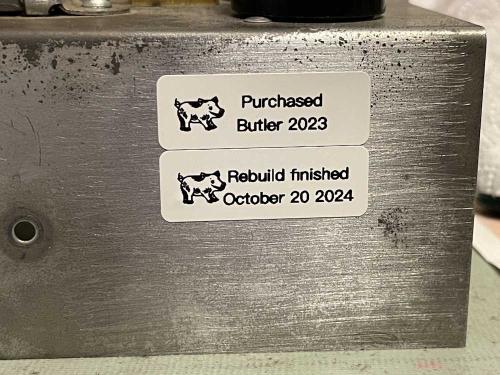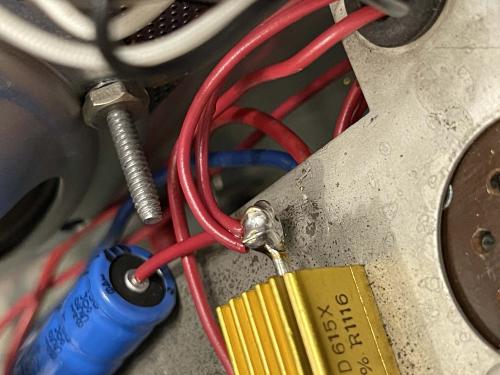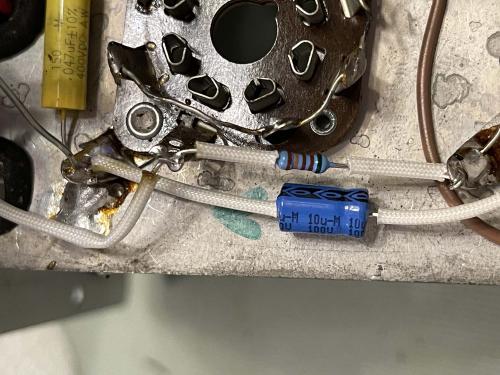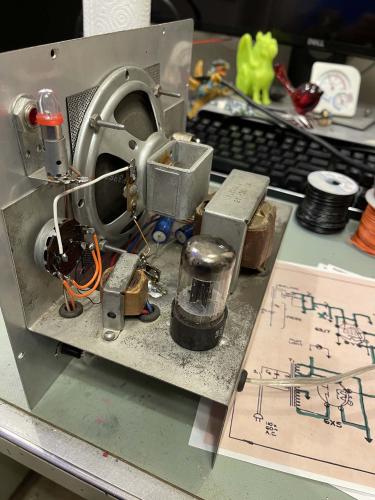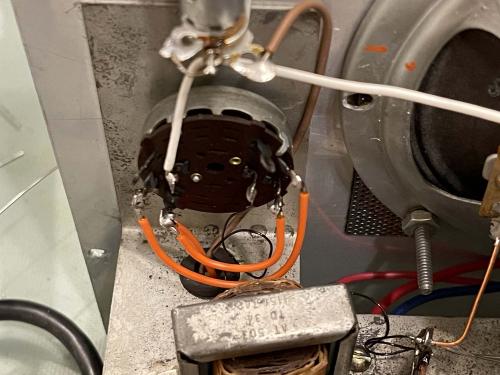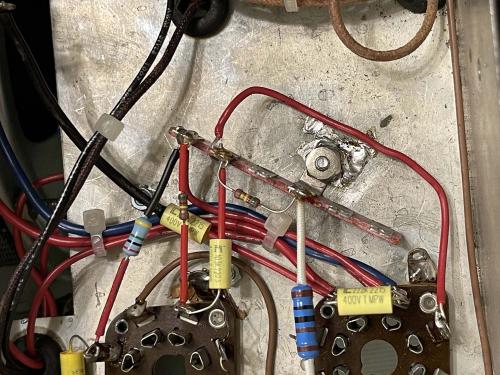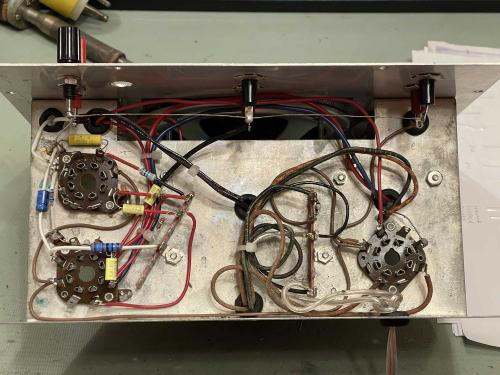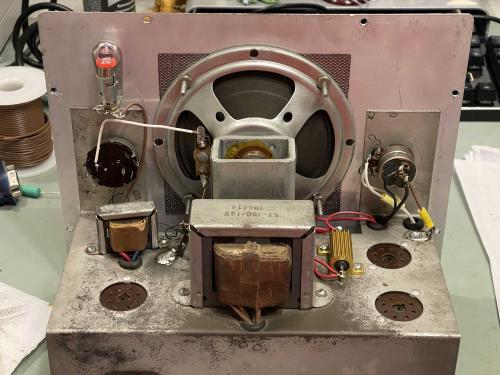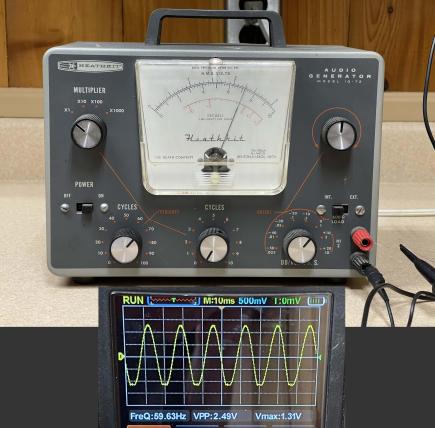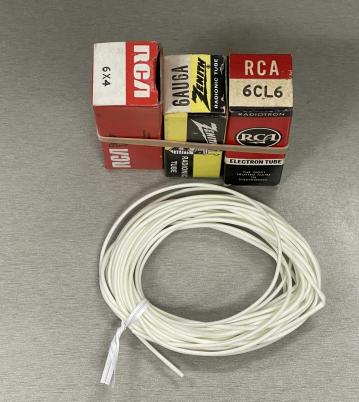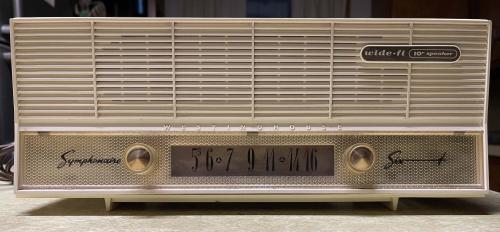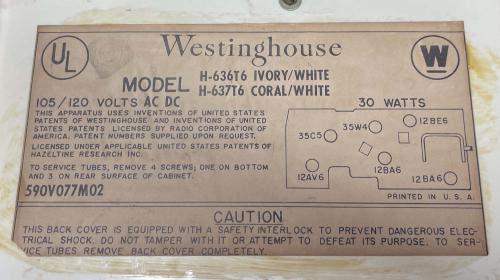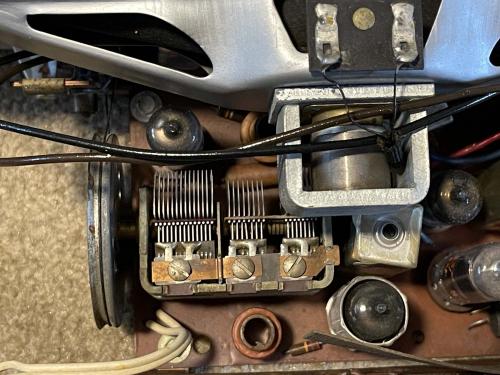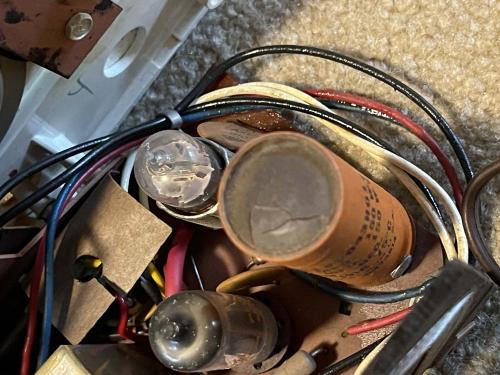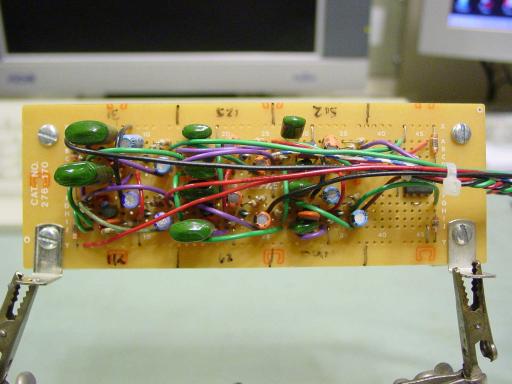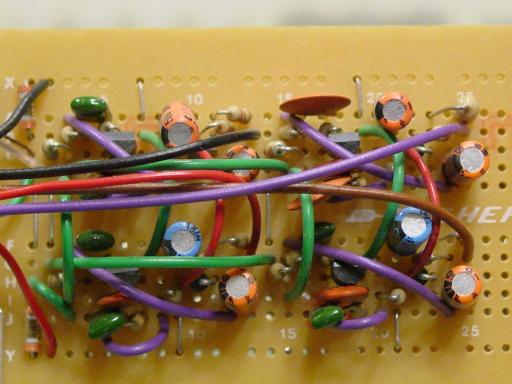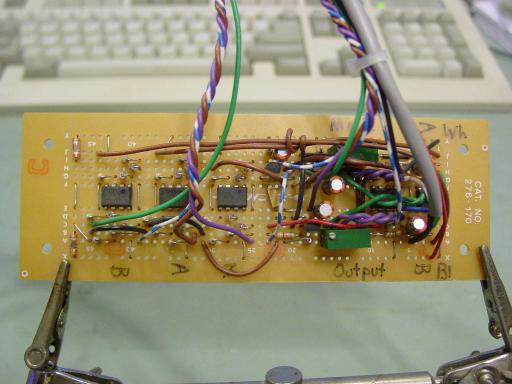- 2024
- Oct
- 21
An Eico 145 Signal Tracer - Wrapup and final thoughts.
The signal tracer rebuild has been finished and happily amplifying sound again. What’s next? Here’s some thoughts on this device, and the rebuild process in general.
On the rebuild process:
1. Research the device.
Looking the device over and gathering things like schematics and assembly guides are a necessary first step, but don’t overlook the fact that these devices have been out there for decades. Plenty of people have had them in their possession, and there’s plenty of after the fact info available. Modifications, parts swaps to increase life, general deep dig things that may assist you in putting the thing back together. Read everything you can about the device before starting.
2. Some other tools you may need.
One of the greatest inventions I have on my bench is a tool called an orange stick. It’s not orange in color, but made from (traditionally) orange tree wood. It’s similar to the sticks that nail salons use in that it’s a double-ended stick with wedge-shaped ends - except that it’s longer. These are a soft wood that won’t mar parts, and can be used to push wires and wire-ends around for forming, as well as a soldering block for parts close together. They have a million uses. I highly suggest adding a pack of these to your tool kit.
Also, don’t be afraid to have more than one soldering iron on your bench. I regularly have my trusty 30W Weller, but keep an 80W unit handy when doing chassis work. You may find that having multiple wattages, multiple tips, or even multiple size units on the bench to be of use. You may even find a small butane torch to be useful here. Don’t limit yourself to just one.
3. Parts.
When you’re ordering parts, don’t use the crap you find on Amazon or eBay (unless you can verify it’s of known pedigree.) Get known parts from one of the supply houses. You don’t need to use the absolute top-tier part (unless you want to!) but get a good part. Always get an extra or two as well, in case you break something. It happens! Don’t go crazy buying 100s, but if you need 9, get 10 (and possibly a price break.) Be aware that some parts may have inductance (wire-wound resistors) and you want to avoid that kind of thing unless replacing like-for-like.
4. Be aware of voltages and values!
Capacitors are easily rated by the nomenclature printed on the part. Get at least the rated voltage and value here, but don’t go nuts. You don’t need a 1000V part where a 400V part was specified, but if all you can get is a 500V part, that’s fine. You’re not going to get the exact same values today for most of the stuff (except resistors) so don’t be afraid to go up a little in value. A 22uF part will easily replace a 20uF part in the power supply without issue - just don’t fall into the “more is better” trap because it’s not. Stay close to the rated design specs.
Resistors are a special case. For the most part, the 1/2W resistors used then are easily replaced today. However, be mindful of the voltages - you can be working with 300, 400, 500+ volts here, and parts need to be rated for the working voltage of the circuit. For example, if you have a resistor that’s rated 2W but it’s 2 inches long, then it’s probably a higher voltage device. Using a resistor rated for 500V in a 100V circuit isn’t going to hurt anything.
And, always remember you’re working with line and higher than line voltages here. Don’t be afraid of it, just give it the respect it deserves.
5. Grounds.
Grounds are important. Always make sure your contact points on the chassis are clean, and use washers that dig into the chassis if you can. Soldering those grounds to chassis for a good contact point will also work, but make sure you get a good connection otherwise oxides will build up and give you more grief than you started with. Good fluxing and a clean shiny spot for soldering is important here. Scotchbrite (plastic “steel” wool pads) is your friend here!
6. Signals.
It’s always been good practice to lay your filament and AC wires right on the chassis if possible, and to keep your low-level audio away from those, if possible. Keep it short and covered.
7. Don’t be afraid to modify!
Unless it’s of vital importance that a circuit be laid out the way the manufacturer did it, don’t sweat it if you see a better way. Add a terminal strip to bring parts out from hotspots. Add holes to mount new parts instead of trying to replace the exact old ones. Add a fuse. The manufacturers probably tried to work the assembly to use the least amount of extra parts, but you can take whatever luxuries you need.
8. Be mindful that you’re not the first owner.
There’s probably going to be modifications in the device. There may be added or missing parts. It may be that someone was trying to make the device do something else. Note these modifications before you begin, but don’t necessarily use them as a guide for rebuild unless you can see that it was trying to fix something.
9. Don’t be in a hurry.
The important advice with any kit. Take your time to lay out parts and wires. Check things as you go along, and check it all again when you’re done.
My thoughts on the device itself and rebuilding it…
This is a fairly simple device in terms of operation. A power supply, a preamp, and a power amp. Not much going on here, but there were still some modifications made.
The 6K6 power output tube is run electrically hot in these, about 1W above rated specs according to what I’ve read and calculated. It was suggested that the cathode resistor, R5, be increased from 470ohm to 1kohm. I did so in this rebuild. C10 was missing on my device for some reason, and that was added back in. R5 is the resistor that provides current for the cathode, and C10 is a bypass capacitor to help improve fidelity of the amplified signal. It’s possible that C10 went bad at some point and was removed, as the device will operate just fine without it. I couldn’t see any evidence that it was ever there, however.
I’m not a purist, so I didn’t care how the power supply turned out. The old capacitor was discarded and two new parts were laid in it’s place. I decided to use a 500V non-inductive 25W aluminum resistor here, bolted directly to the top of the chassis, with the capacitors going to a ground also on the top. That probably offended some people, but I need functionality here, not a beauty contest winner. The reason I used the aluminum resistor is because it’s non-inductive, and was available to me.
Terminal strips were reused where possible, with new ones added. These allowed me to space the parts out more, which should help life in the terms of heat related death. It also allowed me to use two back-to-back diodes in the filament circuit to cut down on the voltage, since the device was designed to run on 110 - not the 125VAC we commonly see in the USA these days. Where something was grounded, the tabs for the terminal strips were soldered directly to the chassis to provide a good ground. It’s not the prettiest thing, but who cares.
Last, I had to remove and correct some of the modifications to this device. One of those nasty Amphenol microphone connectors on the front panel was removed (and needs to be filled at some point,) and the audio output transformer was bolted down. The audio transformer in the device didn’t fit the holes provided (device was narrower,) so I don’t know if this was because the original part was bad and was replaced at some point, if the chassis was drilled wrong, or what. A new hole for the transformer and a terminal strip to provide ground for the power supply mounted in the old hole fixed both those.
The only other thing is deciding how to fill the front panel hole. I could use a BNC connector, but since this probably will never see IF frequencies, do I care? Originally, I though about just plugging it with a plastic plug I had laying around, but I’ve kind of warmed up to using that hole as a ground tie point, or maybe just a tie point in general that’s not connected to anything internally. Who knows at this point.
During the final check, I discovered two errors.
The first one was I put a 510k resistor where a 10M should be. I think I know what happened here - I had a 10M there, but didn’t like the way it laid. I pulled it out, saw the blue stripe, and looked at the blurry schematic. I then assumed it was 510k and put that back in place. It’s been long enough that I forgot I actually bought 10M parts, so this was completely my fault.
The second was the b+ connection to the junction of R3/R4 wasn’t laid in. I remember looking at this and thinking I already had too much crap on the one tie point, and intended on going back later to put this in. “Later” just happened to be the last step, so this is both my fault and me claiming I meant to do that.
There’s still that hole in the front panel. I think I’m just going to go with my original thought and plug it.
But…that’s it! This device has been well used, looks like it’s Seen Things - that’s part of the charm of this device. It’s rusted and has spray paint on it and some scratches. It’s a piece of equipment that’s worked it’s entire life, and it’s ready to do it again. I’m not interested in “restoration,” I want the device to look like it does. So…crank up the 1KHz and let’s get some radios repaired!
Recapping the journey (and the device!)
Purchasing the unit at the 2023 Breezeshooters Hamfest in Butler PA.
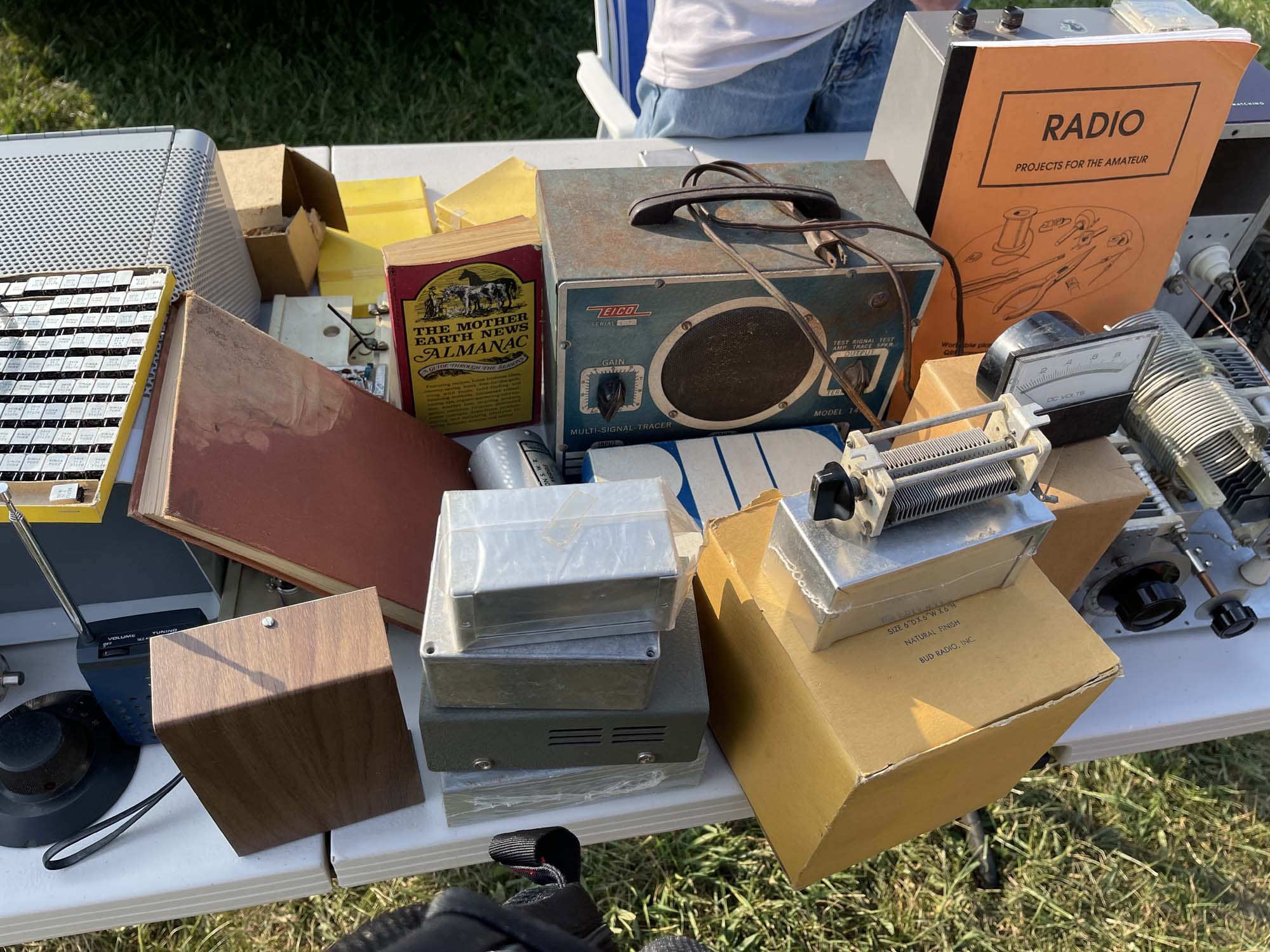
It was obviously a kit unit.
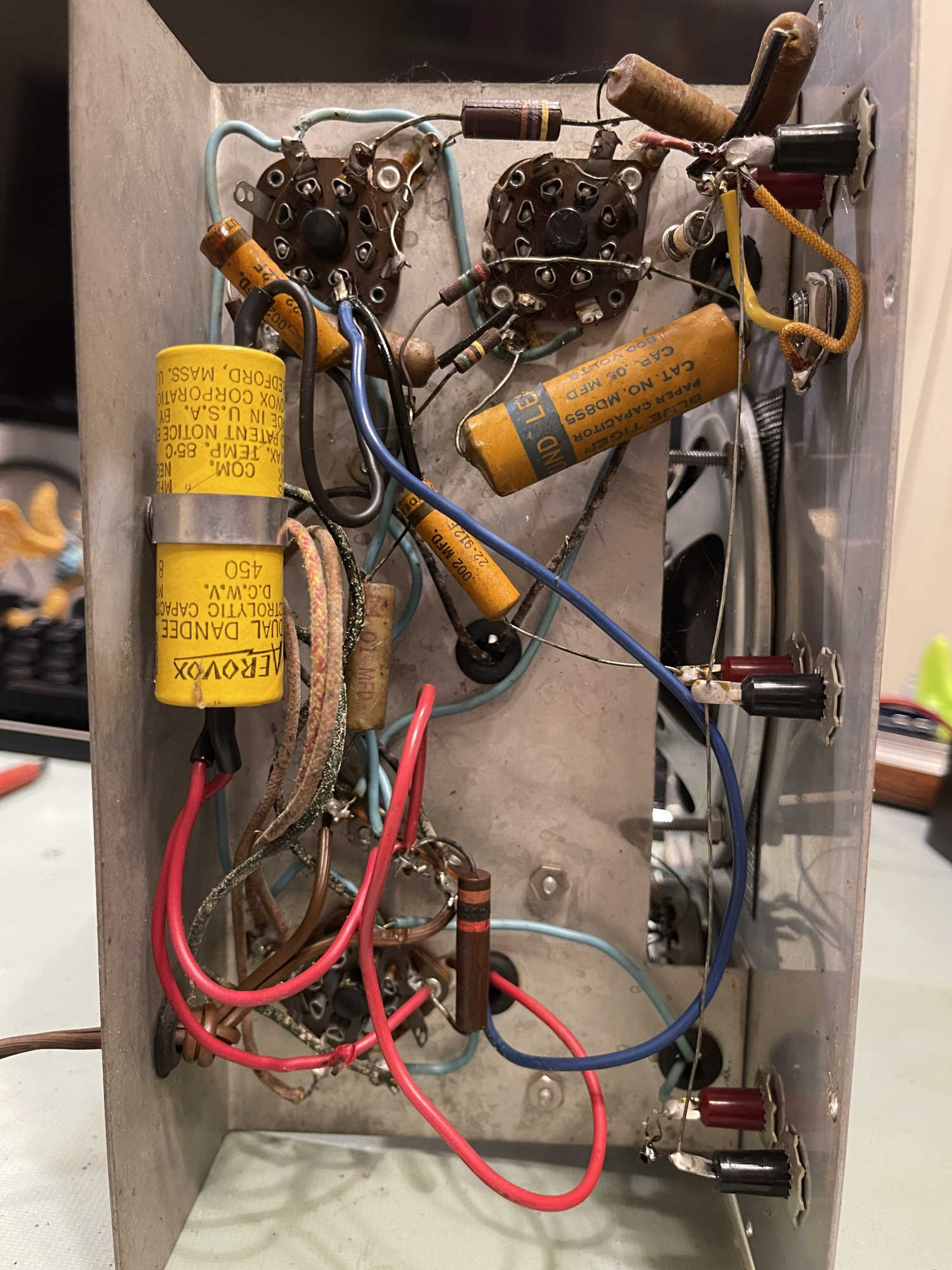
Some cleanup on the physical parts of the device, then removing everything.
All the parts are out.
Putting things back in, one part at a time.
It lives!
And, we’re done.
The entire series from start to finish:
Purchasing the unit at Butler 2023: https://wereboar.com … fest-2023-butler-pa/
Initial evaluations on the device: https://wereboar.com … o-145-signal-tracer/
Part 0 - Some thoughts on parts inside: https://wereboar.com … ignal-tracer-part-0/
Part 1 - Collecting ideas and parts: https://wereboar.com … ignal-tracer-part-1/
Part 2 = Cleaning the device: https://wereboar.com … ignal-tracer-part-2/
Part 3 - Let’s get some parts: https://wereboar.com … ignal-tracer-part-3/
Part 4 - Some more prep work: https://wereboar.com … ignal-tracer-part-4/
Part 5 - Let’s take it apart: https://wereboar.com … ignal-tracer-part-5/
Intermission - Component notes: https://wereboar.com … cer-component-notes/
Part 6a - Starting the rebuild: https://wereboar.com … tarting-the-rebuild/
Part 6b - The power supply: https://wereboar.com … ng-the-power-supply/
Part 6c - Halfway there: https://wereboar.com … -to-run-a-few-wires/
Part 6d - We’re almost done: https://wereboar.com … art-6d-almost-there/
part 6e - The parts are in: https://wereboar.com … the-rebuild-is-done/
Part 7 - Check your work: https://wereboar.com … -checking-your-work/
Part 8 - And, it’s done: https://wereboar.com … art-8-and-were-done/
Wrapup - You’re reading it now.
It’s been over a year since that first evaluation, thank you for coming along on the journey. I think the next device will be the signal generator I picked up at the Scioto Valley hamfest. Stay tuned for more good junk, I mean equipment!
Previous part of this series: https://wereboar.com … art-8-and-were-done/
- 2024
- Oct
- 21
An Eico 145 Signal Tracer - Part 8 - And, we’re done.
This is the last part of the Eico 145 rebuild series. I’ll have one more post in regards to this unit, but that will be a wrap up and general thoughts on the rebuild process.
As in the previous post, I found a couple of mistakes in my work during the final check Those were corrected easily enough by adding a wire from the B+ point to the junction of R3/R4, and changing the 510k back to a 10M resistor. It turned out I did have the 10M resistors, and had ordered them.
I think what happened here is because I didn’t like the lay of the first part I used, I pulled it out. I didn’t pay attention and just grabbed a 510K because I saw the blue stripe. I’ll lay some blame on the blurry schematic, but most of the fault here lies with me. That’s why I checked my work.
The B+ line was a simple oversight. I remember running the rest of the B+ circuit and, because I had too many wires on one connection point, thinking to myself that I need to find a second tie point for the rest of the voltage. I didn’t do that. Again…checking your work is important. No matter how long you’ve done this kind of work, check it when you’re done.
The new 10M resistor gave me a chance to lay it in nicely.
I did put some other resistors in there for testing before I remembered the parts I bought specifically for this unit, specifically these two 4.7M carbon comp resistors that I just stuck out the side. Parts layout is important, as this gave a lot of hum:
Don’t do this. It made for a lot of noise, and it just reinforced the need for keeping your layout clean. Keep stuff short and close to the chassis. It did prove to me the device worked, however.
With that being said, all parts are placed.
I’m still not completely happy with the layout, but everything is soldered and tight. It’s not going anywhere.
Everything powered up with no issues. You can’t really see it as these devices don’t have much glow, but the rectifier on the left side has that tell-tale orange of the heater.
Put some labels on the back for posterity, and…
And it’s all done.
It still has some minor hum, but nothing like the whine it had with the 10M hanging out the side, and it’s a bit quieter than when I got it. I’m happy with the results, and I spent 10 minutes or so listening to some talking head on the crystal radio drone on about some topic that’s going to destroy everything or something, I don’t know.
There’s one more not-part of this series on the way where I wrap up thoughts and provide some things I’ve learned on the way to this point. Stay tuned, that should be ready to go later this week. That post will have links to all of the posts so you can easily start from wherever you like and read from there.
Stay tuned!
Final part of this series: https://wereboar.com … -and-final-thoughts/
Previous part of this series: https://wereboar.com … -checking-your-work/
- 2024
- Oct
- 20
An Eico 145 Signal Tracer - Part 7 - On the importance of checking your work.
Always do it.
Tonight I sat down with the Eico 145 and ran through the schematic, checking all parts. I found 2 errors.
1. The B+ line wasn’t run to the junction of of R3/R4 for the 6SJ7. This is my oversight, I remember looking at that and figuring out how to lay it out. There was an awful lot going on on the same connection to the 6K6, and I forgot about it.
2. R2, the input to ground resistor for the 6SJ7 was a 510k. I have no idea why I did this, I wrote down “order a 10Meg” and didn’t. That’s not a big deal, I just need to grab one from somewhere. I don’t have any, so I’ll probably just order a few from Mouser next round. That’s a decent value to have around for tube stuff.
Now for show and tell…
You’ll notice there are now 3 wires on the B+ side of the device. 1 for the filter, 2 for the feeds to the unit.
You’ll notice that’s not a 10Meg resistor.
I had two 4.7M carbon comps. They make 10ish megs. They’ll work to test the unit.
With all of the wiring matching the schematic, I put the rectifier in, plugged it in to the isolation transfomer, and hit the switch. The rectifier lit and B+ went to 393V. That’s good. Filaments at 115VAC are running around 6.5VAC. That’s not ideal , but better than the 7+ it was hitting before the diode mod. It may need some more diodes, I’ll consider that later.
With all of the first voltage checks good, the next step is going to be putting in the rest of the tubes and seeing what happens. Stay tuned!
Next part of this series: https://wereboar.com … art-8-and-were-done/
Previous part of this series: https://wereboar.com … the-rebuild-is-done/
- 2024
- Oct
- 19
NTE Electronics is gone.
NTE, or New-Tone Electronics was probably a name familiar to anyone that has been in the electronics business for any length of time. Much like RCA’s SK line, NTE made and self-packed replacement transistors, resistors, and other parts for the replacement and hobby industries, and had folded the Sylvania ECG line into itself some years ago.
According to reports, the company was sold in 2022 to owners who mismanaged the company and drove it into bankruptcy.
This removes the last “replacement” company from play.
A company called Vetco Electronics has picked up some of that lineup, packing parts using NTE/ECG’s numbers, so all is not lost. I assume they’ll use the same foreign sources that NTE used, but who knows. You can find their announcement on the matter here: https://vetco.net/bl … -09-11-14-39-26-0700.
So long NTE. We’ll miss you.
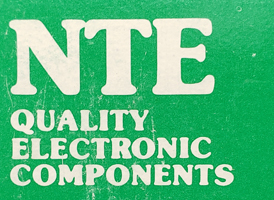
- 2024
- Oct
- 16
An Eico 145 Signal Tracer - Part 6e - The rebuild is done.
For this last part, I actually used the assembly drawing to put the wires on the switch. Yeah, I know, I RTFM…
There wasn’t much left to do, three wires for the switch and a couple of joints to finish soldering.
Two jumpers on the switch, and one that goes down to the output terminal on the front panel.
I also decided to hit one of the grounds on the bottom with solder. I removed the bolt from the terminal strip and gave it a quick shine with some scotchbrite, held it in place with an orange stick, and tried to get solder to flow under the tab. Wile it did, I also pooled the solder…the ‘ol 80 watt iron just wasn’t up to the task here. Regardless, I now have a good ground connection here. This was particularly important because this is where the grounds for the amp portion are fed, and I wanted to make sure that no extra resistance was in this circuit - not that it will really matter of course, but the oxides on the chassis may have not given the best ground. Screw went back in, and we’re good to go.
That’s it for the wiring. I tried to follow the schematic exactly, so there shouldn’t be any wiring errors. I hope, but that’s what the next part will be - just tracing things down and making sure it’s all in the right place. I need to get a highlighter or two so I can mark up the schematic.
Only two parts left, and maybe some extra cleanup once I decide what to do with the hole in the front panel. Stay tuned!
Next part of this series: https://wereboar.com … -checking-your-work/
Previous part of this series: https://wereboar.com … art-6d-almost-there/
- 2024
- Oct
- 16
An Eico 145 Signal Tracer - Part 6d - Almost there!
Last night, I did the filaments, AC line, and the rest of the components, since I had enough (new) wire sleeve to coat them all. A valiant 330Ω resistor gave it’s leads for the capacitors feeding down from the volume control, and I replaced the 510k with a fresh resistor because I didn’t like the way the one I placed looked.
I’m still not totally happy with the way some of the components lay, but they’re all solid. I need to touch up some of the joints, but some look worse than they are because of the flux. I’m not worried about that.
The switch needs to be wired in, and there’s a few joints to touch up and solder in. The switch shouldn’t take that long to finish up.
There’s a little more to do, and then it’s “Check your work!” After that, I’ll bring it up with just the power supply to check voltages. Assuming all is good - we’ll have sound.
Stay tuned for part 6e, 7 and 8, which should finish this series. I’ll have a “my thoughts” at the end of the series as well, hopefully with some things I’ve learned about the process and what not to do.
Next part of this series: https://wereboar.com … the-rebuild-is-done/
Previous part of this series: https://wereboar.com … -to-run-a-few-wires/
- 2024
- Oct
- 15
Fixing the Heathkit IG-72 Signal Generator
Since there doesn’t seem to be a lot wrong with it, I’ve decided to go all in on fixing the IG-72 I picked up at the Scioto Valley hamfest. As you can see, it’s kind of out of balance with the bottom half of the signal being a bit flat.
This starts with new tubes and a re-balance, which seems bring these guys into line. The meter will also need recalibrated - much easier these days with the ultra-high impedance voltmeters allowing for direct calibration of the device.
I picked up some new tubes from Antique Electronic Supply.
I don’t really care what the brand is.
As a side note, you can purchase old-school wire sleeve (spaghetti) from Antique Electronic Supply as well. It’s sold by the foot, with the black being more expensive - I assume due to it’s authentic look for older devices. I chose to get some white because I’m restoring for use, not because it’s pretty.
You can get some of that for yourself: https://www.tubesand … tti-old-style-20-awg
This probably won’t end up on the bench for a while, but I’ll post my findings when it does.
- 2024
- Oct
- 14
email services for pygg.xyz have been terminated.
When I migrated this blog from pygg to wereboar, I left a few of the services running on pygg.
One of those was email - I didn’t need it, but I left it alone for whatever. In retrospect, that was a bad idea since my host refunded unused time, but that’s another story…
If you’re emailing any pygg.xyz addresses - and the logs revealed there were quite a few recruiters still banging away - you can remove those addresses from your lists. I don’t plan on using that domain again, and will simply let it expire in 10 years or so if no one wishes to purchase it. In the meantime, pygg will redirect to here - assuming the redirects work. I’ve noticed there’s some BS with that happening, but it seems to be stable for now.
Pygg.xyz is for sale, send me a message on LinkedIn or Mastodon if you’d like a short domain name, cheap.
- 2024
- Oct
- 12
An interesting Westinghouse Radio
I was at an antique store today and walked past a display with multiple radios. One caught my eye - obviously an AA5 in pretty good shape. The color is rather boring, but that’s not really an issue for me. There were a few others, a clock radio and some transistors. One was marked working, the others were all marked “Does not warm up.”
Of course the transistor radios don’t warm up, not having any tubes….
I purchased the one, it was also marked “Does not warm up.” Ok…that’s rather odd for a direct string radio, but whatever.
It’s kind of neat - the entire front is a speaker. The label, however, revealed something interesting about the unit.
There are 6 tubes in this thing? That can only mean it’s got a tuned RF front end. This thing should be a good performer if it works. But it “Does not warm up?”
Opening it up, it’s most certainly a tuned RF front end. Three gangs on the tuner.
I noticed that the tuning dial is kind of wonky, it binds at the front and slips elsewhere. Not a big deal, that’s almost expected.
I also noticed that the power switch was push-pull. I can almost guarantee the person selling it turned the knob and didn’t get a click, so they automatically assumed it was dead.
I gave it a good look over. There’s a lot of different brands of tubes in there. This thing has seen a lot of hours. But I immediately noticed something else, something that is probably the issue.
The filter is kind of funny with cracks in the top. So…put it back together, plug it in, pull the knob out…the ZZZZZZZZZ of bad filters greets me.
So, problem solved. There’s no AM stations where I am, so I didn’t get anything under the hum. The filter is easy enough to get out, and I think I have some extras at home. This will be a quick weekend project to at least get it cleaned up so I can diagnose any other issues.
Once we get the filters changed, stay tuned!
Next part of this series: https://wereboar.com … -h-636t6-aa51-radio/
- 2024
- Oct
- 10
An audio analyzer project idea from years ago.
A long time ago, I had an idea to make a 10 band audio spectrum analyzer out of meters. I’d use a pre-existing circuit from another device for the band filters, and then rectify it using precision rectifiers. Some other glue circuitry was needed, but I don’t remember everything that was planned for the device.
I couldn’t find enough of the same kind of small meter I wanted to use, so the project got shelved. Eventually, I got rid of the big audio system and no longer had a need for it - but it’s kind of a neat idea and I would still like to complete it. Seeing as how eye tubes are available from overseas sources at a decent price, it may be interesting to revisit this with those instead of meters.
There were four board completed for the project before I didn’t have need for it anymore:
This is the board for the lower 6 bands of a 10 band unit. They’re simple wide-band bandpass filters with a center loosely around the frequency of input. The more eagle-eyed among you may recognize this circuit from that Radio Shack graphic EQ with the multicolor LED display that they sold in the early 90s. It’s right out of the service manual for that device.
This is the board for the upper 4 bands. Same as the lower 6.
This is the lower 6 band precision rectifier. They’re all full-wave bridge rectifiers with an op amp to provide gain for the circuit so that it combats the drop of the diodes. Ge diodes were chosen because of their cheapness (at the time!) and their relatively low voltage drop and fast recovery. This was to provide DC for the meters themselves, which would be directly driven by the output of the op-amps.
1N34 aren’t really cheap these days, but you can still get big packs of them from auction sites relatively cheaply if desired.
I really don’t remember what this board was supposed to do except combine the two inputs at an equal rate. It was going to be doing some other stuff as well, as evidenced by the remaining circuitry - but I can’t remember what that was supposed to be. I’d probably just set this aside and spin up a new precision rectifier and input board if I were to re-start this project.
That’s as far as I got before shelving the unit. I think I’ll revisit this over the winter.
